No-shows are a major concern for restaurant owners, as they can seriously impact your establishment’s expected revenue and operational efficiency.
However, there’s a way to combat them.
No-show fees are a common strategy used to minimize the impact of those guests who fail to honor their reservations.
This article delves into the positive and negative aspects of charging no-show fees at your restaurant.
We aim to offer valuable insights into the pros and cons of implementing no-show fees, empowering you to make informed decisions on this vital topic.
By understanding the advantages and disadvantages of adopting this practice, you can craft a strategy that best aligns with your business objectives.
Now, let's begin by exploring the benefits.
The Pros
Charging no-show fees can provide a couple of notable benefits for your restaurant.
When carefully implemented, this strategy can potentially address some of the most pressing challenges of managing reservations.
It not only encourages diners to honor their bookings but also contributes positively to the restaurant's overall financial health and the well-being of its staff.
The following sections will cover three key advantages of adding no-show fees to your establishment’s reservation strategy.
We will begin by addressing the obvious one—reducing the number of no-shows.
Reduces the Number of No-Shows
One of the most compelling reasons to charge no-show fees is the potential to decrease the number of missed reservations.
Guests often fail to show up or cancel their reservations for various reasons. This Quora user lists some of them, shown in the screenshot below.
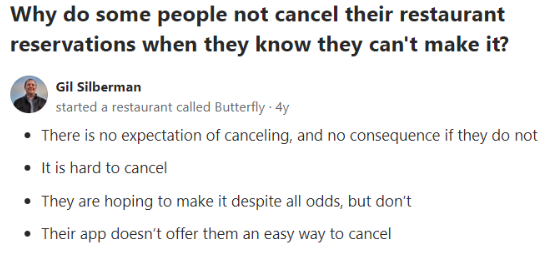
Source: Quora
Besides technical and personal reasons, Gil Silberman mentions the absence of consequences for not canceling a reservation on time.
With modern reservation software, booking a restaurant table can be done on any device in a couple of minutes.
However, this efficiency means that people can make reservations quickly and impulsively, without being sure they have the time to show up.
Implementing a fee can effectively discourage guests from making reservations they are not committed to and ensure they show up or cancel early on.
The manager of Le Cochon Aveugle, Victoria Roberts, mentions the benefits of introducing no-show fees in this article from The Guardian.
She says that having to pay a £50 fee was enough to deter guests from unexpectedly canceling or failing to show up, and she rarely had to actually charge the fee.
We’ve only had to charge two tables in two years… It’s had the desired effect.
The best way of implementing these fees is by using a user-friendly and straightforward table reservation software like our own solution, Tablein.

Source: Tablein
With Tablein’s powerful integration with Stripe, you can customize your late cancellation or no-show fees according to your needs.
After the initial setup, Tablein will display the no-show policy straight onto its clear and simple interface, making it easy for potential customers to understand fully.
To illustrate, take a look at how the UK restaurant Dark Horse Mumbles implemented this feature using our tool.

Source: Tablein
Guests will be able to see the no-show policy and fee amount displayed on the booking screen and have to enter their card details before completing the reservation process.
In this way, customers who are hesitant or unsure about making a reservation will be encouraged to commit fully before booking a table.
So, by imposing no-show fees, guests are more likely to honor their reservations or, if they decide they can’t make it, be motivated to cancel in a timely manner.
Creates a Financial Safety Net for Restaurants
Building on the previous section, let’s see how the reduced number of no-shows can create a financial cushion for your business.
Financial stability is paramount for restaurant owners, especially considering the low average profit margins that plague the industry.
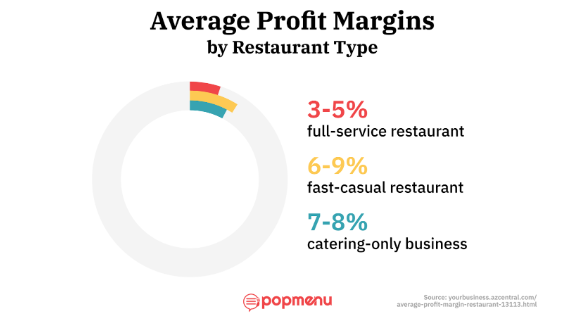
Source: Popmenu
Restaurant profit margins are typically slim due to the high operating costs, including the cost of sold goods, labor costs, and overhead.
No-shows worsen the financial strain on restaurants, resulting in lost revenue and wasted resources, ranging from more tangible ones, like the perishables in your pantry, to intangible ones like the time and effort of your staff.
Guests who don’t turn up for their bookings cost the hospitality industry around £17.6bn per year, and they are likely also affecting your business.
Calculating your no-show rate is the first step in assessing this adverse effect.

Illustration: Tablein / Data: AppointmentReminders
For instance, if you have an average of 50 reservations per day and an average of 8 of them are no-shows, you would divide 8 by 50 and multiply that number by 100.
That would get you a no-show rate of 16%.
You can compare this number to the average no-show rate of all restaurants, which is around one in five reservations.
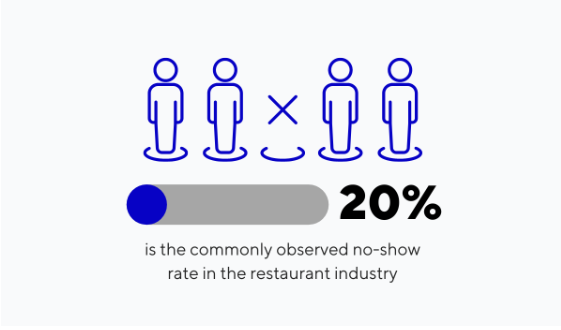
Illustration: Tablein / Data: TouchBistro
But how does this translate into lost revenue?
Let's say those 50 reservations per night have an average spending of $60 per guest.
The restaurant would generate $3,000 in revenue in an ideal scenario without no-shows.
However, with a 16% no-show rate, you would lose $480 in potential revenue each night, which amounts to $14,400 monthly.
Implementing a no-show fee can better protect your business from lost revenue.
For instance, with a $30 fee automatically deducted from the credit cards of the guests who fail to show up, you can lower your losses by $7,200 per month.
You can adjust the no-show fee according to your financial situation, helping you ensure that your restaurant is running smoothly even in the face of unexpected missed reservations.
Provides More Job Security for Staff
The financial stability you gain from no-show fees can also secure your staff’s earnings.
As you can see from the data illustrated below, restaurants have a very high turnover rate compared to other industries.

Source: Notch
These rates have stayed high until recently, with the average employee tenure lasting only 110 days.
As we will demonstrate, no-shows are a contributing factor to these numbers.
When a no-show occurs, restaurant owners still need to pay their staff, even though they're not generating the expected revenue from those empty tables.
This can cause labor costs to increase substantially.
To better understand what we mean, let's consider the labor cost formula.

Source: LunchBox
When a restaurant has a high percentage of no-shows, total sales decrease, and labor costs go up as a result.
Let’s consider the example in the formula above. If a restaurant loses $3,000 from no-shows, the total sales will drop from $12,000 to $9,000, and the percentage of total sales that goes toward labor costs will rise to 44.4%.
What may eventually happen is that these costs become unsustainable, and an owner has to let some of their staff go.
However, even if owners can somehow avoid laying off staff due to higher labor costs caused by no-shows, that still leaves them with a significant problem that needs to be addressed.
Here’s what it is.
Most of the wait staff’s earnings come from tips. In fact, according to statistics, the percentage earned from tips amounts to more than half of a server’s salary.
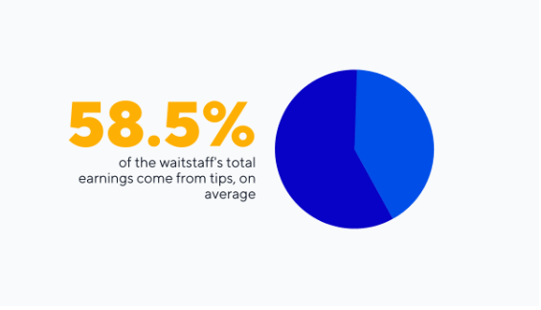
Illustration: Tablein/ Data: Nelp
As the no-show percentage increases, the number of tips staff can earn drops.
In this situation, employees may eventually leave and find an establishment with a more consistent flow of diners rather than wait for the restaurant owner to make staffing or policy changes.
If you ensure more consistent bookings and cash flow in your establishment, your staff will be consistently paid and able to earn tips, which will give them a more stable work life and consequently motivate them to stay working for you.
This practice not only benefits your employees but also contributes to the overall success of your restaurant.
In conclusion, the three benefits of implementing no-show fees that we discussed can contribute to a more stable and sustainable business environment, promoting a thriving atmosphere for your restaurant and its employees.
The Cons
While charging no-show fees can offer several advantages, it's crucial to consider the potential drawbacks of this approach, as they can affect your restaurant in a couple of ways.
These fees could create unintended consequences that may affect the number of reservations made or even waste your staff’s resources.
As with any business decision, understanding these downsides is just as important as knowing the benefits to make sure no-show fees are right for your business and strike the right balance in implementing them.
So, pay close attention to the two drawbacks we cover next.
No-Show Fees May Turn Away Some Customers
No-show fees may dissuade guests from making a reservation, as they may want to avoid the risk of paying a fee if they should cancel for any reason.
The added layer of financial risk may make diners more cautious when booking a table, since they can be worried about unexpected changes in their plans or unforeseen circumstances.
This fact is backed up by data, with just over half of diners stating that paying a fee if they fail to show up for a booking is acceptable.

Source: Zonal
This data indicates that 45% of customers may opt for a different dining establishment without any no-show fees, potentially leading to lost business for restaurants that enforce this policy.
In addition, certain age groups are even less likely to book a reservation if you introduce a no-show fee.

Illustration: Tablein / Data: Zonal
Younger generations may be more hesitant to commit to reservations with no-show policies for a variety of factors, such as financial constraints, their preference for flexibility, or simply because they want to avoid the risk of incurring additional fees.
To prevent a large percentage of guests from avoiding to make a reservation at your restaurant, you can choose to have a more adaptable way to manage no-show fees.
For example, take a look at some of the ideas illustrated below.
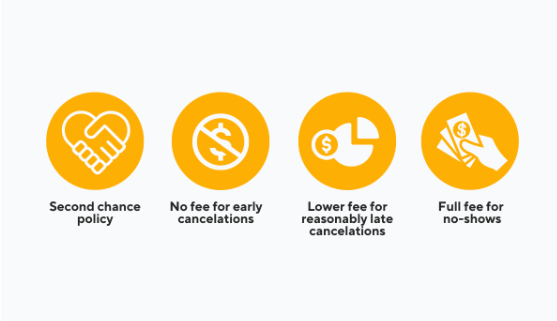
Source: Tablein
If you plan on introducing no-show fees for the first time in your restaurant, you might want to consider easing into this practice and not charging the fee for guests that miss a reservation for the first time.
Moreover, depending on when guests cancel their reservation, you can adjust the fee accordingly. For example, you can do the following:
- Don’t charge anything for cancellations with a 48-hour notice
- Charge 50% of the cancellation fee 24 hours before the deadline
- Charge the full fee when guests cancel with less than 24 hours' notice
Overall, it is possible to minimize the negative impact of no-show fees on customer reservations by striking a balance between protecting the restaurant's interests and accommodating guests' needs.
Customers May Want to Ask More Questions
Another potential drawback of enforcing no-show fees is the increased likelihood of customers seeking clarification about your policy.
Without a clear way for customers to access and understand your no-show policy, they may have numerous questions, such as the ones shown next.

Source: Tablein
Understandably, guests will want answers to these inquiries.
They are likely to call your establishment asking for clarification of any misunderstandings, leading to more time and effort spent by your staff explaining the no-show policy.
If you make the no-show policy clearly visible and understandable, however, guests will be more informed, saving your staff valuable time and resources and potentially lowering the chance of failing to show up.
To do so, try to write out any necessary reservation details on your website or in an observable place within your reservation software.
You can follow the example of London’s A. Wong restaurant, which has the following policy written out on their reservations page.

Source: A. Wong
Clearly and concisely, this reservation policy outlines the expectations for guests when making a booking and the fees associated with cancellations outside the defined notice period.
To show additional consideration for your guests, send a text message or email shortly before the cancellation deadline and the applicable no-show fees.
You can follow the next template for your messages.

Source: Tablein
The messages shown above demonstrate how you can remind guests of any necessary information about their reservation while emphasizing the potential of having to pay a fee for not showing up or canceling on time.
You can send these texts automatically through Tablein, which allows you to create the following types of messages:
- Confirmation SMS
- Reminder SMS
- Feedback SMS
- No-show SMS
- Table’s ready SMS
With automatic notices such as these, guests will be kept informed about their reservation at all times and thus less likely to have to increase your staff’s workload by contacting them for clarifications.
To sum up this section, it's essential to weigh the possible negative outcomes of charging no-show fees to ensure a balanced approach that meets your business's needs and your customers' expectations.
Conclusion
Throughout this article, we discussed the pros and cons of charging no-show fees at your restaurant.
We hope this information has provided you with a well-rounded understanding of the topic, allowing you to make an informed decision that best aligns with your business goals and customer expectations.
By considering the potential benefits and drawbacks of charging no-show fees, you can develop an approach that mitigates the impact of no-shows on your business and fosters a positive relationship with your customers.
With this newfound knowledge, you can now move forward confidently, prepared to tackle the challenge of no-shows while maintaining a thriving and customer-focused dining experience.
Get a 30-day Exclusive Trial
As a Tablein blog reader, you’re eligible for an exclusive 30-day free trial to experience our simple reservation solution for your restaurant.
Enter your business email, and we’ll send you all the steps needed to create your account.
Share this
You may also like

Navigating Restaurant Operations: 6 Challenges Every Owner Faces

5 Benefits of SMS Marketing for Restaurants
